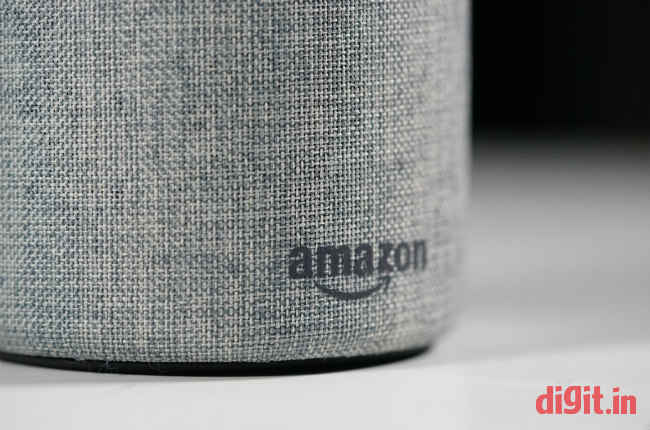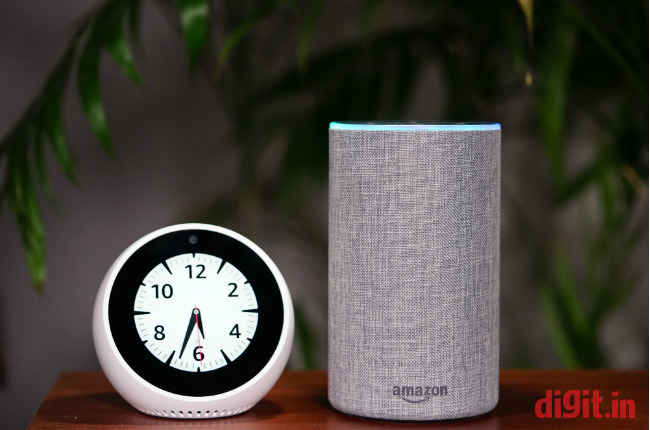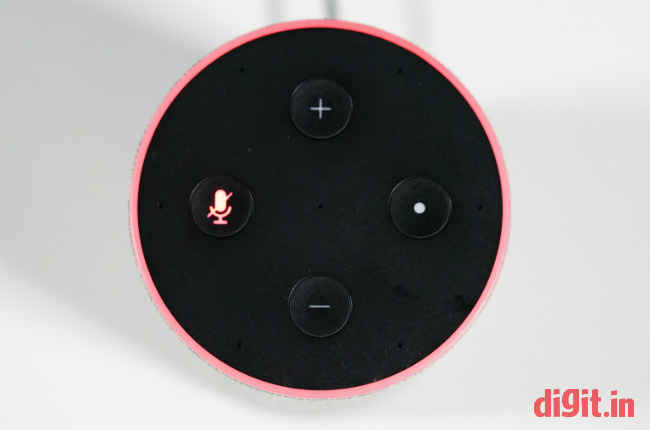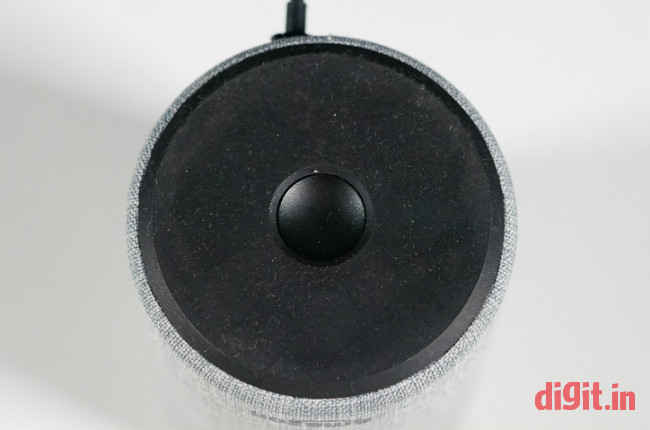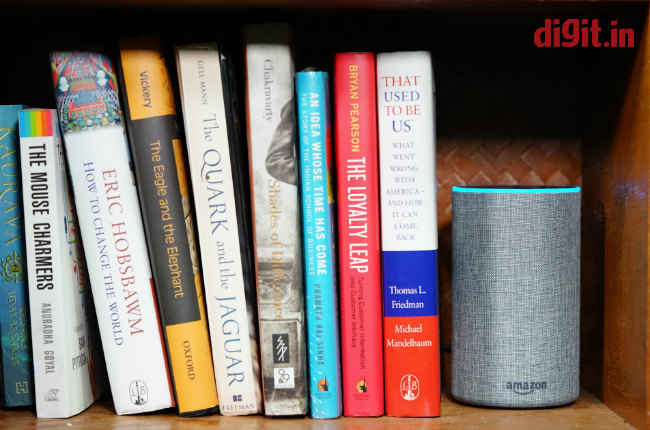Amazon Echo (2nd Generation) Review : Great at vocals, bad at percussions
The second-generation Amazon Echo is smaller in size and has better sound dispersion. Pick one if you like voice-controlling apps on your phone and want a satisfactory wireless speaker for your home.
Design and Build
At 5.8 inches, this second-generation Echo is shorter than its predecessor by nearly three and a half inches. That’s good news for users who like placing their speakers in a shelf. The body now uses a fabric shell instead of a hard shell, which makes the speaker aesthetically more pleasing but not any grippier to hold and lift. The black plastic top of the speaker loses the volume ring but gets two extra buttons for volume control. The light ring stays the same. The pinholes for the seven-microphone array are clearly visible on the top of the speaker, unlike the previous model. On the bottom, there’s a 16mm tweeter, which looks like a tiny inverted dimple. The back side gets the usual round-pin power port and a newly added 3.5mm audio jack, while the front side only bears a subtle Amazon logo. This smart speaker has a rating for neither water-resistance nor dust-resistance.
Fabric shell looks pleasing but isn't very grippy
Personally, I liked the look and feel of the Amazon Echo. The unit under review was the grey colour variant. I found the textured fabric wrapped around the body of the speaker easy on the eyes. At 821 grammes, the speaker was rather heavy to carry around in a laptop bag, but gave the promise of good bassy sound. Just to clarify, the Amazon Echo does not have a built-in battery and needs to constantly be plugged into a power outlet in order to function.
Aux-out present in the 2nd-gen Echo
Setup
Setting up the Amazon Echo is not particularly easy. If you’re used to connecting to non-smart speakers via the usual Bluetooth pairing method, you’ll notice that this smart speaker (ironically, if I might add) needs more than that because it has to be connected directly to a Wi-Fi network for Alexa to work her magic. Doing that requires you to launch the Amazon Alexa app and connect to Echo’s own Wi-Fi network first. From there, you can make the speaker latch on to a Wi-Fi network of your choice. Pairing your phone to the speaker via Bluetooth is a seperate and optional process that you can do after the initial Wi-Fi setup.
Echo standing next to the Echo Spot
With the Echo I had for review, setup was less than perfect. While the Echo speaker had no trouble responding to button clicks, the Alexa app on my iPhone gave me a hard time. It froze regularly and showed the setup page over and over again, even after it had finished setting up and Alexa had greeted me. Eventually, I had the speaker set up. To get Alexa to perform tasks like calling a taxi or even sending messages, I had to sit through a slew of permission screens patiently.
Features and User Interface
As far as features go, it’s all work in progress with Amazon Alexa. She can work with taxi apps like Uber and Ola. She supports food-ordering services like Zomato, Faasos, Box8, and Foodpanda (for re-orders only), but misses out on Swiggy. Alexa supports music services like Spotify, Amazon Prime Music (obviously), TuneIn (needs no account), and Saavn. Spotify support for our country is pretty much useless right now because Spotify hasn’t yet made it to India. Alexa won’t yet play with services like Apple Music, Wynk, and Google Play Music. She can be programmed to work with IFTTT for custom actions, but she won’t work with devices that use wireless standards like Zigbee and Z-Wave. For that you’ll need the bigger Echo Plus.
The Amazon Echo, like the model before it, has no display. All user interaction happens through voice, mobile phone commands, and the four buttons on it. Pressing the Microphone Off button makes the button and the light ring red. The buttons in general are soft enough to press and the device responds instantly on pressing any one of them.
Red light spells privacy
In the time I had it with me at home, the Amazon Echo’s seven-microphone array worked splendidly; calling out to Alexa for requests worked from anywhere inside a bedroom of approximately 14 x 20 feet in size. Often I would play music at about 65 percent volume, and to pause playback I’d call out to her from the shower through a crack in the door. Alexa would catch my voice amidst the loud music and respond eight out of ten times.
Performance and Audio
Requests to play music, hear about weather and news worked accurately seven out of ten times. Amazon Music is the default music services provider and TuneIn radio works without signing in. So, when I shouted, “Alexa; play Kenny G”, smooth jazz music started playing instantly. There was a time when it started playing a random interview with the artist instead of his songs. On most occasions comprehension was as good as Google Assistant’s, if not better. It overlooked filler words like uhms and ers while making requests. This made me feel more comfortable while talking to the device. On other occasions, it either switched the light ring off completely and sat silently or apologised for not understanding me.
Audio quality on the Amazon Echo is acceptable for a speaker of its shape and size, but could be better for a speaker of its price. The Dolby-powered speaker has a 0.6-inch tweeter, through which high frequencies are delivered clearly and loudly. Vocals are clear even at full volume. The speaker also has a 2.5-inch woofer, but bass output is limited. At full volume, the strain on the little woofer can be heard and thumps sound blunt and forced. The speaker feels at home when the volume is set to a value between 70 and 80 percent.
The tiny 0.6-inch tweeter at the bottom
I found the Echo playing songs with instruments like violins and guitars with aplomb but threatening to break up while playing songs with heavy electronic beats. At 90 percent volume, Vivaldi’s Concerto for Four Violins played elegantly, but As Crazy As It Is by ZHU made the little woofer inside bottom out with every beat. All in all, the Echo’s driver setup is ideal for playing tunes that aren’t bass-heavy.
Bottom line
The Amazon Echo is a neat home-improvement product for anyone who wants to enter the world of smart speakers. The ‘smartness’ of the smart speaker depends on the skills Alexa possesses, which for the moment are worth a pat on the back. Alexa’s skills should only increase with time. The speaker’s audio quality is good, but could have been better, especially at full volume. All things considered, the Amazon Echo is a nifty tool to have around at home if you like the feeling of voice-controlling apps on your phone.
Echo sits comfortably inside bookshelves
Reviewer’s Notes
This model needs the 15V 1.4A round-pin charger because of the extra power consumed by the woofer. If it used microUSB to charge like the smaller Echo Dot, portability would have been better. You can’t have both, I suppose.
On one occasion I said, “Alexa; get lost!” and she replied, “I’m sorry, but I can only shop in the primary language associated with your Amazon account…”
When left in the company of three friends for a week, the Echo became an instant hit for song requests and answers to random questions. The three twenty-something women quickly became habituated to yelling ‘Alexa!’ every time they wanted a song played or a joke recited.
Vignesh Giridharan
Progressively identifies more with the term ‘legacy device’ as time marches on. View Full Profile

